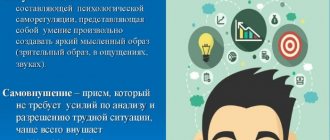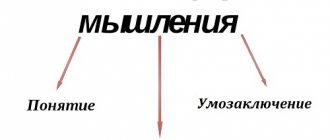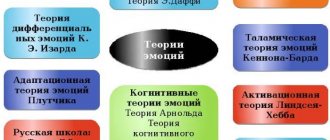Our mental cognitive processes are what make us unique and different from animals. They always work together: our sensations allow us to form an impression of a phenomenon, perception reflects the reality inside our consciousness, thinking involves other brain functions, and so on. In this article, I will define the term voluntary attention and explain in detail what it is in psychology, how it affects our ideas about the world around us and how it interacts with human psychomotor abilities.
How attention works
We live in a subjective world that everyone perceives differently. Attention, being the highest mental function and the basis of all conscious processes, is the building material of this world: if there is not enough attention, the brain completes the image to the whole, but in fact in such completion there is already more fantasy than the real environment.
Gestalt psychology identifies two key functions of attention: highlighting a figure against the background and maintaining concentration on it.
Attention is the process of consciously or unconsciously selecting some information coming through the senses and ignoring others.
The figure can be any object: a mug on the table, music, a thought about vacation, an emotion. The background becomes everything else that fell out of attention, blurred, became unclear: we look at the mug - we don’t notice the plates, we listen to the music - the other sounds are drowned out. Remember the video with the basketball players and the bear? In it, the ball became the figure, and the bear dropped out of sight and went unnoticed.
Turn off notifications on all gadgets
Daniel Goleman in his book Focus. About attention, distraction and success in life” argues that attention is not only a product of the brain. It is also influenced by culture and, in particular, by technology, the active use of which has led to “impoverishment of attention.” Our gadgets allow us to connect to an endless stream of information, and constant notifications make it difficult to maintain focus. Not all messages require urgent notification. The resulting “neural buzz” can overwhelm our ability to concentrate.
If it is not possible to remove notifications completely, leave only the most important ones, and enter other chats only when necessary or after completing a task. You can check your mail at a designated time and add this item to your schedule: for example, the “Check inbox” task should be completed at the beginning of the working day, in the middle and at the end.
What kind of attention is there?
According to the degree of participation in the selection of information, attention can be divided into involuntary, voluntary and post-voluntary
.
Involuntary attention
Involuntary attention is impulsive and reflective: we do not decide where to direct it, but something external pulls us along with it. A person with involuntary attention acts like a rule-following mechanism (and is not far removed from Pavlov's dog). You were doing something important, but now you’ve been thinking about an unrelated thought for five minutes or you can’t get that eclair from the pastry shop out of your head. So you live in the “I want” paradigm, where the external controls consciousness, desire, intention.
Laziness, apathy, low energy, chaos in the head - a consequence of involuntary attention
When attention is out of your control, it is the result of a reactive, "sleeping" consciousness.
. With reactive consciousness, following your attention, your actions, thoughts, and emotions go out of control; they become the result of a reaction to a stimulus. We were praised - we perked up, scolded - we drooped. People wait for motivation, an external stimulus to start acting, and as a natural result they get laziness, apathy and procrastination.
Voluntary attention
Voluntary attention is the independent control of all structures of consciousness: emotions, thoughts, processes, states. Not in response to an external stimulus, but based on one’s own desire and intention. Voluntary attention is always accompanied by greater or lesser volitional effort, and prolonged maintenance of voluntary attention causes fatigue that is stronger than during physical work.
Complete control over your attention and will implies an active consciousness
- this is what is commonly called
awareness
. When we direct our attention and energy towards our own goals, we live in the “I want” paradigm - this is how growth, development, and the creation of something valuable begins.
Voluntary, ordered attention is directly related to activity and energy level. When our heads are in order, we spend much less mental energy, so washing the dishes will sometimes be more relaxing than hanging out on social networks.
Source: francescoch / istockphoto.com
Post-voluntary attention (Flow)
Attention that goes in the direction determined by the subject, but no longer requires constant support by the will, is called post-voluntary attention. The body begins to work in optimal mode and is limited only by natural fatigue and depletion of its resources.
I was told about similar experiences by a neurosurgeon who performs nine-hour operations, an extreme athlete and a conductor who does not leave the console for several hours. The phenomenology of the state was well described by psychologist Mihai Ciksen, but he says little about how to get into it. Studying the methodology for entering the flow state is one of the main questions, the answer to which is now being sought in the area of attention.
A tool for developing attention|An example from personal experience
For me personally, freewriting or freewriting classes, which is the process of writing text on a piece of paper or typing on a computer, for a certain period of time, became a tool for developing attention and training my mental skills while maintaining physical activity.
Of course, the benefits for the physical body are very small, but still, even the simple process of pressing buttons on the keyboard and sitting on a chair in front of a computer monitor requires spending a certain amount of physical energy.
The main benefit for developing my attention is in the area of mental skills that are developed during each freewriting session. It turns out that you need to simultaneously keep in your field of vision both the process of searching for the necessary letters on the keyboard, and the process of thoughts arising in your head and reproducing them in the form of text.
During training, my attention becomes both the manager and regulator of all ongoing processes. In addition, it plays the role of a driving force that provides these processes with the necessary energy resources.
Unfortunately, I don’t know how to touch type, so I have to type with my eyes buried in the buttons on the keyboard. Therefore, when after a while my attention concentrates only on this moment and loses sight of what is happening on the monitor screen, the idea of the story is gradually lost.
When I try to concentrate on my thoughts, which need to be expressed in readable and understandable text, my typing speed immediately drops. So I have to learn the skill of simultaneously concentrating attention and distributing it between objects of observation, which gradually leads to a slight increase in the volume of my attention.
This practice, which I really like, is given by me only in order to more clearly show the process of interaction between the observer and the object of his interest through the power of his own attention. There are a huge number of such tools, a detailed examination of which will take quite a lot of time.
Problems of attention
Clip thinking and ADHD
Attention is constantly being collected and divided (even among those who practice attention management); its switching every 30–90 seconds is a natural property. The body itself encourages us to be distracted by releasing dopamine, the pleasure hormone, when we switch to new information. Dopamine addiction - reward for distraction - creates clip thinking, or the desire to receive information in fits and starts.
Attention Deficit Hyperactivity Disorder (ADHD)
also speaks of a crisis in attention management. In short, people with ADHD are well-rounded individuals who don't get things done. They are fantastic at entering the moment, feeling its fullness, but immediately lose interest when the intensity of the experience subsides.
External environment
Modernity places special demands on the speed of information processing, so the outside world also constantly distracts us. For example, many experts will become unclaimed if they fall out of the process of updating their skills for just a year. This is why we are so eager to multitask, hoping to divide our attention into several processes in order to get everything done.
Tests appear in the form of situations of uncertainty: for example, a crisis and a pandemic pose new problems, trying to take control of our attention from us, and stress impairs concentration. It's no wonder people find it increasingly difficult to see clearly and act effectively.
Source: francescoch / istockphoto.com
Attention - limited resource
The attention resource has a limited volume, and we spend it in all conscious processes: when we work, listen to music, watch a movie, and even during light sleep. By wasting the resource of attention, we deprive ourselves of the strength to concentrate on the main thing, we cannot complete important tasks to the end and we experience stress.
Attention is currency
Where there is attention, there is activity, energy, manifestation. Attention can be exchanged for work, emotions, money, so the ability to own it and independently determine where to direct it is a kind of luxury. We often go bankrupt every day, and the stake in this game is life, just not the one that ends with age: it’s about being in the moment, consciously living every second.
In the future, it is the ability to concentrate for many hours, an active position and the ability to go beyond stereotyped thinking that will determine leaders and professionals in every field.
Return to a calm state through breathing
Your ability to concentrate depends on your mental state: the more anxious your mind, the more difficult it is to maintain focus. Before starting work or training, you need to return to a calm state. Amishi Jha, an assistant professor of psychology at the University of Miami and a neuroscientist at the UMindfulness Initiative, recommended regular breathing exercises in her TED Talk, “How to Tame Your Wandering Mind.”
Jha advises sitting in a comfortable vertical position in silence and paying attention to the sensation of breathing, feeling cold or warm air. “Focus on what is connected to your sensory experience. When your mind wanders away from this sensation toward internal mental content or external distraction, gently bring it back to the object of breathing, says the neuroscientist. - Don’t be surprised if a lot of distracting thoughts come to you during a 15-minute session. Think of your brain as a puppy you are training to walk on a leash. Gently redirect him every time he leaves.”
How to develop attention
We remember that the purpose of attention is to pick out figures from the background: this is what is called concentration
.
But there is also a reverse process, deconcentration, alertness
, when there is no figure, but only a background, completely filled with attention. When we perceive the world holistically, we find ourselves in a state akin to flow, accumulating all experience at the edge of the moment and ready to take our ideal action. How can you boost your attention?
Cognitive simulators, or special programs and games
Pros: they give good results at the beginning, when the brain is still faced with a new task - it stimulates sleeping areas and promotes progress.
Cons: Once the brain adapts, addiction sets in. Progress in mastering the simulators continues, but the skill does not transfer to life. When working with simulators, you are working with an external stimulus, but it will not put your brain in an active position: there is simply no object outside that would draw your attention to itself.
However, simulators work effectively in conjunction with formal (occurring in isolated situations) and informal (occurring in real situations) practices.
Formal practices - Eastern approaches (yoga, Dzogchen)
Pros: meditation is still the most effective tool for working with attention.
Disadvantages: Conscious yoga and qigong practice impose certain ideological restrictions, which may be unacceptable for some people.
Source: francescoch / istockphoto.com
Informal practices
Pros: various game and metaphorical trainings and exercises to engage in the moment, as well as playing out real situations with the activation of dormant cognitive functions give a good shake-up to the brain and activate attention.
Cons: without systematic work, the result quickly fades away.
Thus, disparate practices, ideology and esotericism, as well as cultural restrictions can generally slow down mass attention work. To scale it up, a special engineering technique is required, which would have a scientific basis and has proven its effectiveness on large projects.
Volitional techniques
Pros: Unlike eastern practices, psychonetics is aimed at results and creativity and is therefore suitable for the active life of a purposeful person.
Disadvantages: you need to independently find an approach that will work for you; regularity also plays a key role.
The word “will” is directly related to attention; we can safely say that one follows from the other. It is by taking a strong-willed position that you begin to control your attention and live in the “I want” paradigm. An example is the case of Natalia Molchanova, a record holder in freediving, who, with the help of volitional practices, solved the problem of blackout - loss of consciousness and orientation in space during deep dives. A volitional position implies observation of the mechanisms of consciousness and allows you to correct its work even in such extreme situations.
free
The main feature of voluntary attention is its connection to conscious aspirations and controllability .
This type is subject to will and labor effort.
This type is also called active and intentional.
Physiological mechanism
The basic function of voluntary attention is the regulation of mental processes . The physiological mechanism is based on selective activation of parts of the cerebral cortex and their functional unification under the influence of controlled local activation.
Psychological feature
When a person needs to achieve a certain result, he develops an action plan that includes the task of concentrating on something in order to suppress the involuntary desire to “spray” attention on more pleasant and exciting things.
A person is guided by the “should” category, meeting the requirements of the activity.
Voluntary attention is not determined by the contrast of external influences. In the process of concentration, a person ignores intense stimuli and can concentrate even in the absence of interest .
After 20 minutes of deliberate concentration, the individual becomes tired and the ability to control attention weakens.
Young children are not subject to voluntary attention , since consciousness is not yet sufficiently developed.
Managed concentration on something is developed after two years.
How do achievement motivations and failure avoidance motivations work? You will find the answer on our website.
Examples
Examples:
- The individual needs to prepare a report for the meeting. He consciously excludes the possibility of being influenced by irritants (TV, loud noises outside the window, messages in instant messengers), organizes his workplace and concentrates on the necessary documents, forcing himself by force of will to ignore pleasant thoughts about the upcoming weekend and meeting with friends.
- The girl crosses the road. At this moment, she is occupied by a beautiful showcase on the other side of the street.
But she deliberately concentrates on traffic rules and passing cars in order to avoid getting into an emergency situation. - Being in a noisy office, the employee deliberately does not listen and diverts attention from the interesting conversation of colleagues , paying attention only to the current business correspondence with the client, since it is necessary to close the deal before lunch.
- The guy set himself the task of reading two chapters from a physics textbook, after which he could go into the yard and play football with his friends. By an effort of will, he is distracted by an interesting TV show and immerses himself in reading in order to quickly cope with the task.
If the will is not sufficiently developed or the task at hand is not important/priority, the person may have difficulty with deliberate concentration :
- The schoolgirl decided to complete her homework for the next school week in advance. But realizing that there is nowhere to rush, she is constantly distracted by the sound of the wind, a kitten sleeping next to her and a fashion magazine on the table.
- The employee was asked to fill out statistics that, in his opinion, would not play a significant role in the work of the department. But the need to complete the task forces him to use deliberate attention .
However, he does not feel the significance of his activity and constantly “disconnects” from the process, going to pour himself some coffee, buy a chocolate bar and replace a broken pencil.
Children's attentiveness
Spontaneous responses arise and persist regardless of our goals. Due to their fascination or surprise, stimuli capture and distract the individual from his activity.
Face-to-face consultation
What are the features and advantages of face-to-face consultation?
Find out more
Skype consultation
What are the features and benefits of Skype consultations?
Find out more
Babies are unable to concentrate on one specific object. They are fascinated by a variety of things - a cell phone, mom's cosmetics, dad's tools. At this age, babies are very curious. When a child grows up, he receives a lot of information and learns that on our planet there are a large number of animals of various species, insects, and plants. They begin to understand people better, distinguish hair color, eye color, skin color.
At the very beginning of life, parents help babies comprehend the world; they instill their own attitudes in the child, explain the line between good and evil, and teach them to talk. Then the baby himself begins to explore everything around him, reacting to what seems bright, unusual and unknown to him.
Children cannot regulate their own attentiveness, since they have passive concentration. Therefore, kids are attracted to various strange objects that come into their field of vision. A child may carefully look at a toy that was given to him, enjoy it, but after a minute switch to another thing. Therefore, it is easy to calm a baby down when falling or crying - you just need to distract him from the painful sensation or an unwanted object.
The ability to concentrate on one object appears in a child in the sixth year of life. I recommend praising him for any manifestation of perseverance and willpower before this age - since this is not easy for a baby. Praise will let him know that his efforts are appreciated, so he will begin to try harder to please his parents with his small victories.
If all attempts at attentive concentration are in vain, do not scold your child, ask him to try again. By reacting negatively, you will discourage your child from all the desire for knowledge, learning and perseverance.
Peculiarities
Spontaneous concentration is the primary form of mindfulness, which arises due to external impulses - phenomena, people, objects.
I will indicate the main features of involuntary attention:
- it functions in our subcortex;
- the person does not prepare himself to perceive an unexpected situation;
- the intensity of the response is determined by the shape of the stimulus;
- short duration of concentration on the moment.
Conditions
This mechanism of instant reaction was formed in the process of evolution; it helped weak animals to escape from predators in time, and it also allowed predatory representatives of the fauna to track down prey. Of course, people are not afraid of animals, and to get food, they visit stores. However, when an unexpected stimulus occurs, we respond to it. Now I will list what is the condition for the emergence of involuntary attention:
- movement - an object that is at rest does not pose any danger, and therefore does not act as an irritating factor;
- impact - a strong sound signal or a quiet rustle in an empty room, our consciousness perceives a bright unexpected light as a threat;
- the unknown – it can lead to trouble, so we react to this event.
Reasons for appearance
Such concentration does not depend on the individual; it cannot be controlled. I will list several reasons why a person is distracted by external factors.
- The nature of the stimulus. Any loud sound, strong knock, or blinding light provokes the individual to respond. If he is very interested in something, he may not notice these factors, for example, during an interesting computer game or sports competition. However, during sleep or while reading, we react to sounds that are unusual for us.
- The stimulus corresponds to the internal state. The average person and a football fan will not have the same reaction to a conversation related to football. The first will calmly react to the stimulus, the second will expressively prove his point of view.
- Matching interests. If you have certain hobbies, they will always attract your attention. A designer can be distracted by looking at an interior that delights him, and a photographer can be distracted by a beautiful photo that interests him.
- The influence of stimuli on feelings. A person who experiences a strong interest is filled with a certain range of sensations and emotions. Emotional reaction is the main reason for the appearance of involuntary concentration.
The positive side of an involuntary reaction is that at the right moment the person will be able to find the cause, identify the irritant and figure out how to get rid of it. Also, such attention makes it easier to return to your usual activities.
Psychologist Daria Milai
Make an appointment
The negative side appears when, due to reaction to street noise or any conversation, the productivity and quality of the work performed suffers.
Also, such attentiveness allows you to see the traits that are inherent in a particular individual - frivolity, irresponsibility, simplicity or depth of feelings, kindness. A beautiful landscape and a building of amazing architecture attract artists, since these objects influence their aesthetic perception of beauty. However, an ordinary person will pass by these species, simply not noticing them.
Write down distracting thoughts and actions
Make a “not to do” list. Every time you want to check social media, news resources, or can't get rid of an idea, write it down. By transferring these thoughts onto paper, you will thus get rid of them. However, if some of them appear again, this signal should not be ignored - think about why this or that issue is bothering you and how it needs to be resolved.
Take regular breaks
It is impossible to maintain attention for a long time, this leads to fatigue and loss of concentration. According to several studies, you should spend 52 minutes on one task and then take a break for 17 minutes. Also, the well-known Pomodoro technique suggests taking 5-minute breaks every 25 minutes.
During the break, you can do small physical exercises that improve concentration and memory. This is how a special protein is formed in the hippocampus - brain-derived neurotrophic factor (BDNF), which promotes the formation of new neurons.










